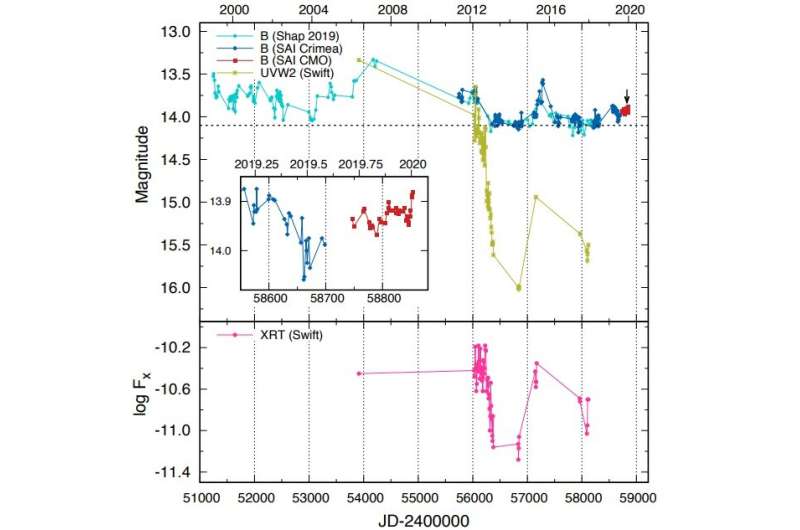April 13, 2020 report
Flare detected from the galaxy NGC 3516

Astronomers have conducted photometric and spectroscopic observation of a changing-look Seyfert galaxy known as NGC 3516. During this monitoring campaign, the researchers detected a flare from this galaxy that may provide important information about its nature. The finding is reported in a paper published April 2 on arXiv.org.
An active galactic nucleus (AGN) is a compact region at the center of a galaxy, more luminous than the surrounding galaxy light. They are very energetic due either to the presence of a black hole or star formation activity at the core of the galaxy.
Astronomers generally divide AGNs into two groups based on emission line features. Type 1 AGNs show broad and narrow emission lines, while only narrow emission lines are present in Type 2 AGNs. However, observations revealed that some AGNs transition between different spectral types—they are known as changing-look (CL) AGNs.
NGC 3516 is a Seyfert galaxy located between 124 and 215 million light years away. A long-term optical monitoring campaign of this galaxy has confirmed that it is an CL AGN. The observations have shown that its broad Balmer emission lines almost completely disappeared in 2014, but in 2018, a weak, blue-shifted and asymmetric broad component started to reappear.
Recently, a team of astronomers led by Dragana Ilić of the University of Belgrade, Serbia, decided to take a closer look at NGC 3516 and its behavior by conducting a short-term intensive optical observations of this source with the Caucasus Mountain Observatory (CMO). The new study, completed by archival data from NASA's Neil Gehrels Swift Observatory, found a new flaring event in this galaxy.
"Here, we report on the very recent flare discovered during the latest intensive photometric monitoring in U and B filters, which may be an indicator of NGC 3516 transitioning from a low to high state activity phase," the astronomers wrote in the paper.
The flare occurred in the end of 2019. It was observed as a general increase in brightness in the U and B band, to a maximum amplitude of 0.25 mag and 0.11 mag, respectively. The amplitude of variability in the U band was found to be significantly bigger than that in the B band.
Moreover, during the flare, stronger forbidden high-ionization iron lines were observed than reported by previous studies. This suggests that the AGN is moving toward the more active phase.
The astronomers added that the very broad component of about 10,000 km/s width is starting to appear, what also supports the scenario of AGN's transition to the higher-activity phase.
"The photometric and spectroscopic observations presented in this paper indicate that the AGN of NGC 3516 may be in the transition phase, changing from the low to high-activity state," the researchers concluded.
However, the authors of the paper noted that further intensive multiwavelength monitoring of NGC 3516 in photometry and spectroscopy is required to definitely confirm the transition of its AGN.
More information: A flare in the optical spotted in the changing-look Seyfert NGC 3516, arXiv:2004.01308 [astro-ph.GA] arxiv.org/abs/2004.01308
© 2020 Science X Network





















